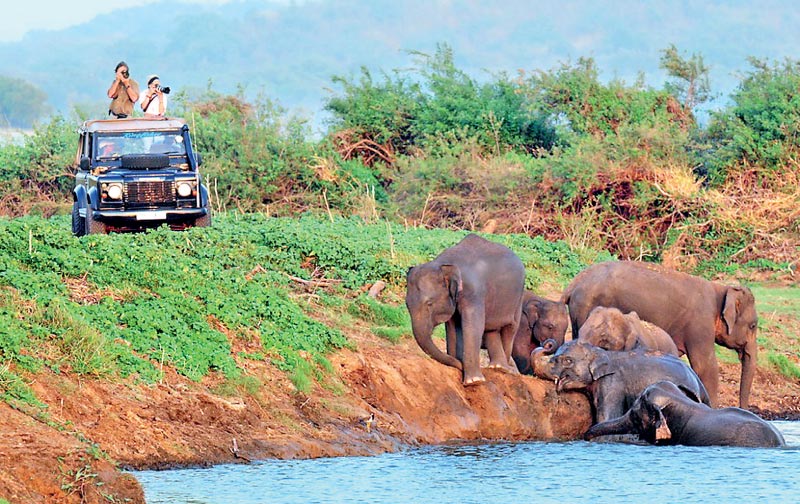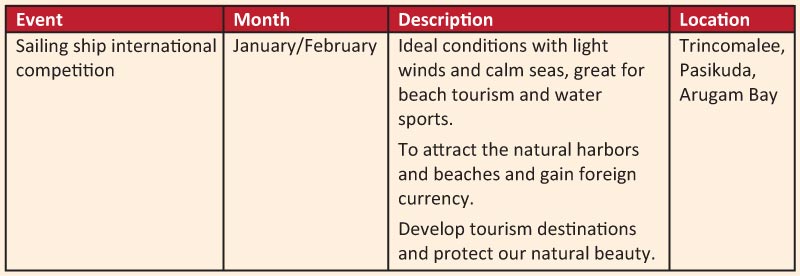Monday Jan 12, 2026
Monday Jan 12, 2026
Thursday, 4 January 2024 00:00 - - {{hitsCtrl.values.hits}}

 In the heart of the Indian Ocean, an enchanting haven awaits the island nation of Sri Lanka. A tapestry of culture, history, and nature, it beckons travellers with a siren call that resonates across its landscapes. The tourism industry, a vital economic pillar, stands tall, contributing a substantial 12% to the nation’s GDP and serving as a cornerstone for employment. Despite recent tribulations, the echoes of the Easter Sunday bombings in 2019 and the pervasive shadow of the global COVID-19 pandemic in 2020, Sri Lanka stands on the cusp of a renaissance. A renewed optimism permeates the air, marked by an estimated 496,400 tourist arrivals as of August 2022.
In the heart of the Indian Ocean, an enchanting haven awaits the island nation of Sri Lanka. A tapestry of culture, history, and nature, it beckons travellers with a siren call that resonates across its landscapes. The tourism industry, a vital economic pillar, stands tall, contributing a substantial 12% to the nation’s GDP and serving as a cornerstone for employment. Despite recent tribulations, the echoes of the Easter Sunday bombings in 2019 and the pervasive shadow of the global COVID-19 pandemic in 2020, Sri Lanka stands on the cusp of a renaissance. A renewed optimism permeates the air, marked by an estimated 496,400 tourist arrivals as of August 2022.
As per the Government expectation, this study has been revealed that whether condition, location, culture, historical background of the country brings us to make a significant destination to enhance tourism industry in Sri Lanka. As per the analysis of the tourist destination and scope, this has been conveyed to the right direction of the tourism development in the country.
Sri Lanka’s tourism canvas is nothing short of a stunning success, painting a picture of unparalleled diversity and richness. Beyond the world-famous beaches that have graced many postcards, the island reveals a trove of hidden treasures. Wildlife parks pulse with biodiversity, inviting adventurers to witness nature’s grandeur. Pristine rainforests echo with the calls of exotic birds, while rolling tea plantations drape the hillsides in a verdant embrace.
This article is going to highlight the seasonal events of the country that can be marketed with our tourism destination as well as it brings to the nation our pride and glamour to the country. We are proud nationalities that can bring nature friendly strategies to the market. This has been shifted to another era of the nation. As per our analysis, this will be totally based on the shape of body in the country that has varied with our historical cultural destination. This model has not modified our natural beauty or existing natural location that has been brought to the world.
Our Sri Lankan beauty can be marketed with our prevailing places that can be made seasonal clock theory to the nation. It has been defined as the nature friendly activities based on the season in the country. In addition it has programmed the event as per the each month and monthly weather condition and geographical location of the country. There are so many examples that can be brought to the activation plan with international events. There are some international competitions that have been nature based hotspots in Sri Lanka. It can be marketed as per our prevailing resources of the country. We are nature friendly humanistic people that can be emphasised to the world with our pride of culture, ethnic, social, artistic, historical, etc. these are the illustrations of the seasonal best event of the country.
Breathtaking mountains international competition
Sri Lanka’s mountain ranges unfold as havens for adventure tourism. Peaks like Sripadaya provide an exhilarating trekking experience, effortlessly blending adventure with spiritual connection. The biodiversity of places like Horton Plains and the Knuckles Conservation Forest, Sapthakanya Mountain coupled with cultural elements such as ancient monasteries, enriches the overall experience.
Sailing ship race international competition
From Unawatuna to Mirissa, pristine beaches allure travellers with well-maintained shores against a backdrop of turquoise waters. Marketing relaxation spots like Bentota alongside water sports hotspots like Arugam Bay cater to diverse preferences. Destinations like Trincomalee and Kalpitiya offer marine activities, enriching Sri Lanka’s coastal appeal.
As the Sri Lanka seasonal clock chart shows, it is beneficial to the nation to recover the financial issues of the economy that may emerge as a beacon of hope and promises. This recovery harmonises with the cadence of the discovery and Sri Lanka reveals not just a destination but an odyssey of resilience, beauty and unwritten chapters that beckon travellers to embark on a journey of a lifetime.
As Sri Lanka charts its course towards recovery, the untapped potential of its tourism industry emerges as a beacon of hope and promise. It is a call to explorers, conservationists, and enthusiasts alike—to venture beyond the known and embrace the unseen. The symphony of recovery harmonises with the cadence of discovery, and in this dance, Sri Lanka reveals not just a destination but an odyssey of resilience, beauty, and the unwritten chapters that beckon travellers to embark on a journey of a lifetime.
This theme aligns with global trends, emphasising national commitments to responsible travel practices. While countries like India, New Zealand and Thailand have maintained the steady theme for decades that shouldn’t be changed from time to time. Sri Lanka’s adaptive approach reflects the willingness to align with changing trends and traveller preferences that can be varied without changing the original beauty of the destinations. In the Sri Lankan tourist industry, it is having some prevailing challenges in brand consistency, every policy on tourism or any other field that cannot be changed as per the political culture. The Government policy cannot be political party policies that have brought a good lesson for the nation to develop our policies as per the countries perspectives of the nations. Sri Lanka should contribute to the rich tapestry of destination, inviting travellers to embark on unique journeys shaped by distinctive themes and narratives.
The impact of shifting policies on Sri Lanka’s tourism industry
One of the primary challenges arises from the oscillation in tourism policies that tends to occur with changes in Government. The strategies and priorities outlined by one administration may undergo transformations with the ascent of a new leadership, directly affecting the trajectory of the tourism industry. These policy shifts can range from alterations in marketing approaches and promotional campaigns to adjustments in visa regulations and infrastructure development plans.
Moreover, the impact of project changes over time, particularly when there is a change in Government, adds another layer of complexity. Tourism projects initiated under one administration may face reassessment or redirection with the advent of new policymakers. This can lead to delays, modifications, or, in some instances, the abandonment of projects altogether, hindering the sector’s growth potential.
Significance of the seasonal clock model to the nation
Tourist attractions:
By aligning events with the seasons, you can showcase the diverse attractions of each region at their best. This can attract tourists looking for specific experiences, whether it’s cultural festivals, nature excursions, or adventure activities.
Economic boost:
The strategic scheduling of events can contribute to a more evenly distributed flow of tourists throughout the year. This helps in preventing tourism clusters during peak seasons, leading to a more balanced economic impact across different regions.
Cultural preservation:
Celebrating cultural events in line with traditional and seasonal practices helps preserve and promote local heritage. It ensures that cultural traditions are sustained and shared, both among the local population and with visitors.
Diversified experiences:
Different seasons offer unique experiences, and aligning events accordingly allows for a diverse range of activities. This caters to a broader audience with varied interests, keeping both locals and tourists engaged throughout the year.
Optimal weather conditions:
Planning events according to the Seasonal Clock Theory takes into account the weather patterns of each season. This ensures that outdoor activities are conducted in optimal conditions, providing a more enjoyable experience for participants and attendees.
Community involvement:
Involving local communities in the planning and execution of events fosters a sense of community pride and ownership. It encourages residents to actively participate in showcasing the unique offerings of their region.
Environmental sustainability:
Events can be aligned with environmental conservation goals. For example, nature walks and wildlife tours during specific seasons promote sustainable tourism and raise awareness about the importance of preserving natural ecosystems.
Enhanced marketing opportunities:
The seasonal clock model provides a structured framework for marketing different regions at specific times. This targeted approach allows for more effective promotion of events and attractions, maximising their visibility and appeal.
Year-round tourism:
By offering attractions and events throughout the year, Sri Lanka can position itself as a year-round tourist destination. This not only benefits the tourism industry but also creates a more consistent and reliable source of income for businesses in various regions.
Cultural exchange:
Hosting events according to local seasons allows for a rich cultural exchange between residents and tourists. Visitors have the opportunity to immerse themselves in authentic local experiences, fostering a deeper understanding of Sri Lankan culture.
The seasonal clock model practices bring more pride to the nation and enhance their lives by attracting tourist travellers that will be made more loving nations in the world as well as our humanitarian activities are another destination to develop our tourist attraction. The Government needs to pay attention to inculcate this culture around the country that has been a strong strategy to stand as a nation.

(The writer holds a BBM in tourism from the Uva Wellassa University.)